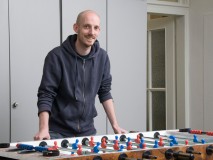Lasse Scherffig

Biography
Lasse Scherffig is an artist and scientist.
From June 2006 until June 2012, he was a member of the artistic/scientific staff of KHM, Academy of Media Arts Cologne, working at Lab3.
He studied cognitive science at the University of Osnabrück, Germany, and SUNY Oswego, USA (B.Sc., 2002); graduate studies in digital media at the University of Bremen, Germany, and Zurich University of the Arts (ZHdK), Switzerland (M.Sc., 2005). He has been a visiting researcher at the Institute for Basic Research of the ZKM, Center for Art and Media, Karlsruhe, Germany (2004-2005), and at the Cybermedia Research Unit of the Knowledge Media Research Center, Tübingen, Germany (April 2007). He is among the founders of off topic, magazine for media art and a founding member of the art and science association Paidia Institute. Since October 2006 he is a doctoral candidate in the field of experimental computer science at KHM.
His collaborative art projects have been shown, for instance, at transmediale 2012, Hessisches Ministerium für Wissenschaft und Kunst, ISEA2010 RUHR, AMAZE at Club Transmediale 10, Computerspielemuseum, gamescom, play festival, Platine Festival, National Art Musuem of China and the ZKM.
Selected art projects
Paidia Laboratory: feedback (ongoing since 2011, with Paidia Institute)
Artistic research into the dispositive of computer gaming and its Cybernetic roots. Shown at Platine Festival, Cologne, transmediale and Computerspielemuseum, Berlin.
Solar Wind Periscope (2011, with Jonas Hansen)
An interface to visualize solar wind activity, based on an international network of HAM-radio stations. Shown at Translife Triennial, National Art Museum of China, Beijing.
Yacht Kaiserstuhl (2010-2011, with Echo Ho)
A sculpture and process about the globalization of trade and labor.
Commissioned by ISEA2010 RUHR and shown at the Museum of Art and Cultural History, Dortmund and outside Dortmunder U. Stolen in summer 2011.
EyeVisionBot (2004-2005, with Hans H. Diebner and Sebastian Fischer)
Experimental interface for gaze based navigation of the image database of Media Art Net. Built with the Institute for Basic Research of the ZKM and shown at the ZKM (Meisterwerke der Medienkunst aus der ZKM_Sammlung 2004-2005, enseigner/produire 2006).
Dissertation project
Feedback Machines
In 1977, Mattel releases the first portable computer game: Football. Players control the game using six push-buttons while its display is limited to a small number of LEDs only. Due to this extreme minimalism of representation, the question arises: How is the dynamics of the game represented at all? At least this representation is not iconic in terms of semiotics, as what is shown here (a football game) bears little or no similarity to the form in which it is shown (by a small number of LEDs). In addition, we may not assume that in 1977 a cultural convention has already been established regulating the symbolism of presenting game events on such a minimalist display. Playing Football instead might be a process that is mediated on two levels: One is the games’ context, comprising its name “Football,” its handbook and the design of the portable device. The other is the technological coupling of game and player. Based on this coupling, the game is not primarily experienced by seeing it, but by playing it.
Computer science has termed such couplings of humans and computers “interaction.” The questions, how interaction functions, how it developed historically and what it is exactly, have been treated from various points of view and with varying foci. The dissertation project aims at providing an integrated view on interaction, trying to explain the low-level psychology of interaction as a psychology of perception in action, the historic emergence of interactive computers from cybernetics, its precursors and early computer science and, based on both, the cultural technique of interacting with computers. Central to the approach will be the notions of feedback and circular causality.

